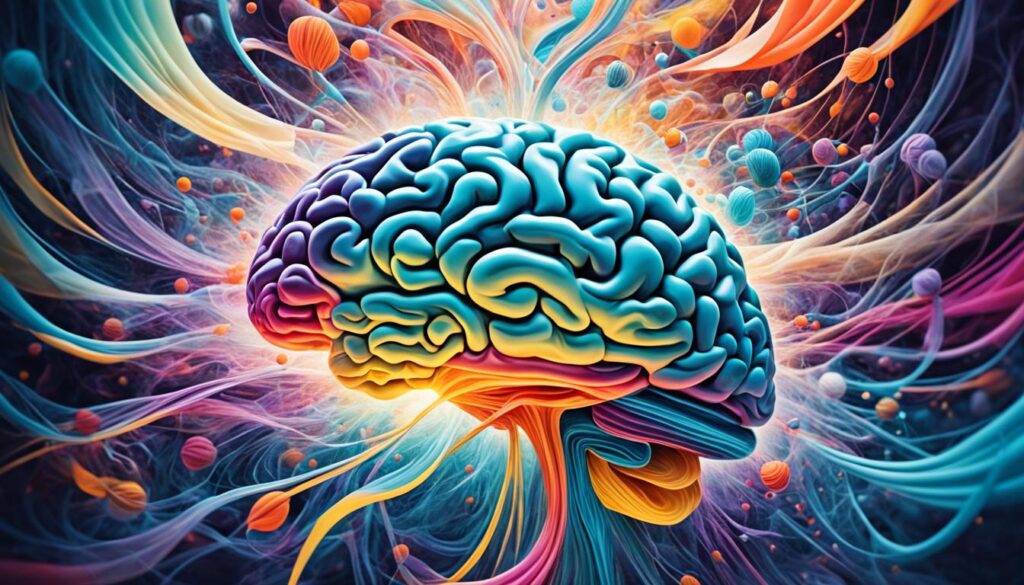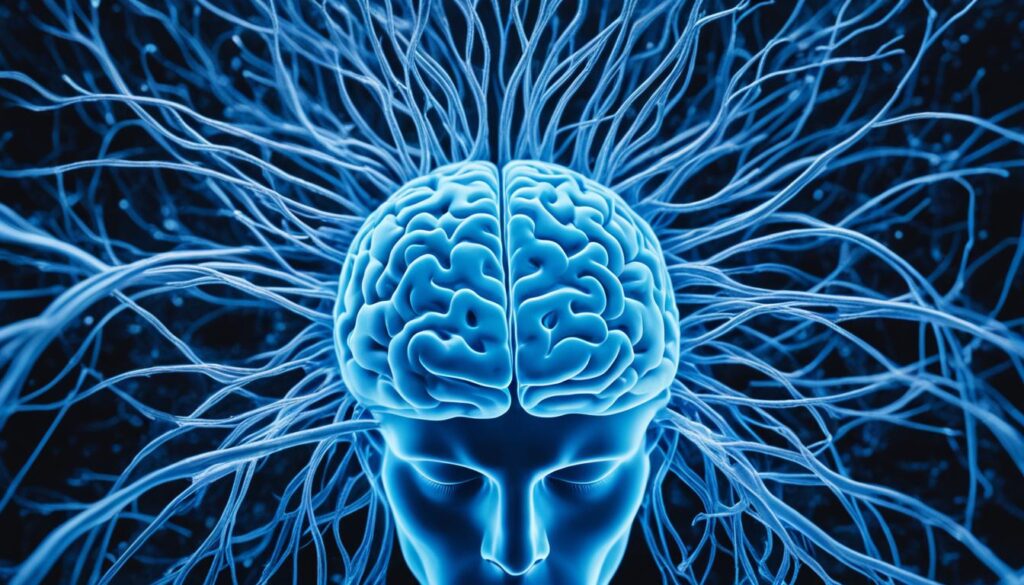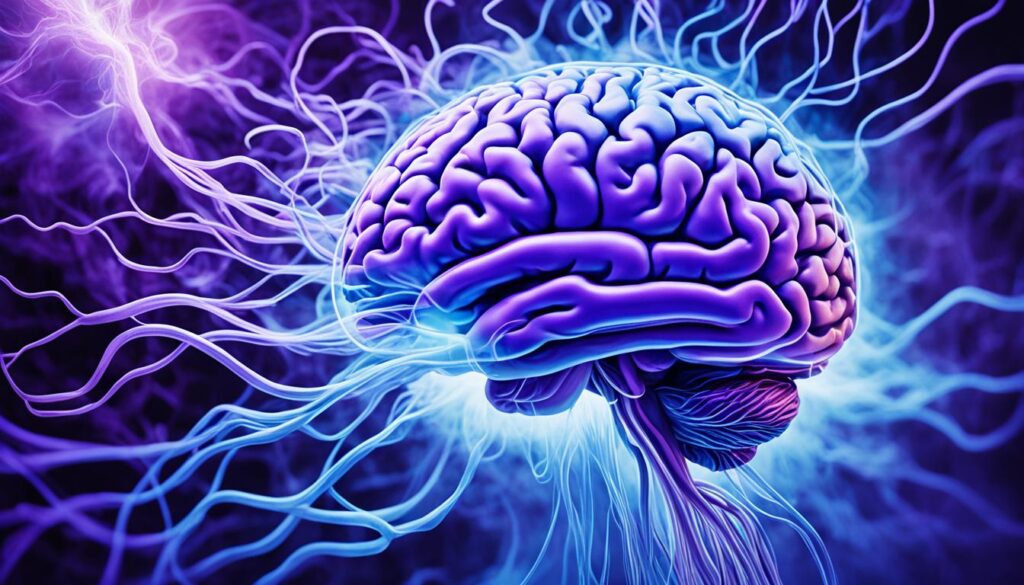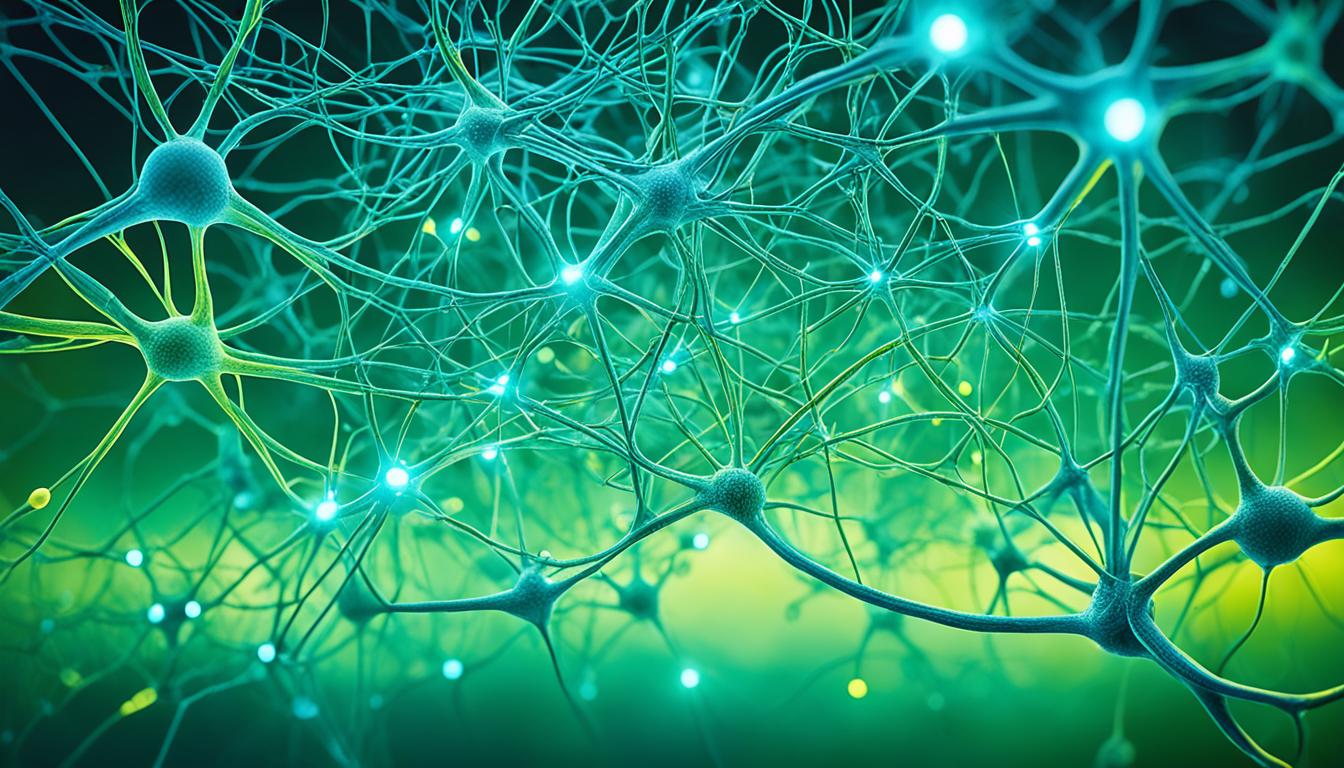Have you ever been in a dream and knew you were dreaming? That’s when you enter lucid dreaming. It’s a special state where you can control your dreams and understand your mind better.
Lucid dreaming happens during REM sleep, when your brain is very active. It lets you see how your mind works and even control your dreams. Not everyone dreams lucidly, but some people do it often1.
Scientists find lucid dreaming very interesting. They use fMRI to see how the brain works during these dreams. They found special areas in the brain that are active when you’re lucid dreaming2.
Lucid dreaming is more common in young people. It tends to decrease after you turn 252. This shows that getting to know your dreams might change as you get older. Some people dream lucidly often, while others rarely do2.
Lucid dreaming can be more than just fun. It might help people with PTSD or nightmares feel less anxious and depressed3. This could lead to new ways to help people feel better.
Key Takeaways
- Lucid dreaming occurs during REM sleep with increased brain activity.
- Only about half of people report experiencing lucid dreams.
- Children and teens are more likely to have lucid dreams.
- Neuroimaging shows unique brain activity patterns during lucid dreams.
- Lucid dreaming may have potential benefits for mental health.
- The frequency of lucid dreams varies widely among individuals.
- Research on lucid dreaming is still in its early stages.
Understanding Lucid Dreaming: A Unique Sleep Phenomenon
Lucid dreaming is when you know you’re dreaming while asleep. It lets you control your dreams. This special brain activity is quite interesting.
Definition and Characteristics of Lucid Dreams
In a lucid dream, you’re more awake in your dreams. Your brain works differently, showing more power in some areas. Research shows lucid dreaming has special brain waves, like those in REM sleep, but also some unique ones4.

Historical Context and Cultural Significance
Lucid dreaming has been around for a long time. Aristotle talked about it over 2,000 years ago. It’s been important in many cultures5. The term “lucid dream” was first used in 1913 by a Dutch doctor, Frederik Van Eeden5.
Prevalence and Frequency in the General Population
Many people have had a lucid dream. About half of us have had one at least once, and 20% have them every month6. But, people tend to dream less lucidly as they get older, especially after they turn 256.
| Age Group | Lucid Dream Frequency | Notable Factors |
|---|---|---|
| Children | Higher | More prone to lucid dreaming |
| Early Adolescence | Declining | Frequency starts to decrease |
| Adults (25+) | Lower | Spontaneous onset infrequent |
Some people are more likely to have lucid dreams. Being open-minded and sensitive can help. This interesting dream type keeps researchers and dreamers excited, showing us more about our brains.
The Neurophysiology of Lucid Dreaming
Lucid dreaming has caught the eye of scientists and dreamers for ages. It happens during REM sleep, when you know you’re dreaming but are still asleep7.
Brain Regions Involved in Lucid Dreaming
When you lucid dream, certain brain areas get more active. The prefrontal cortex is key for knowing who you are and making choices in dreams. The precuneus and inferior parietal lobules help with thinking about yourself and understanding space.

REM Sleep and Lucid Dream Occurrences
Lucid dreams come during REM sleep, a time of fast eye movements and vivid dreams. Lucid dreamers show they’re aware by moving their eyes in special ways. This helps scientists check if someone is dreaming lucidly7.
Neurotransmitters and Their Role in Lucid Dreams
Chemicals in the brain help make lucid dreaming happen. Acetylcholine, linked to memory and waking up, might start lucid dreams. Gamma waves, connected to being awake, grow in lucid dreams. This could help with remembering dreams and controlling them.
| Aspect | Regular Dreams | Lucid Dreams |
|---|---|---|
| Awareness | Unaware of dreaming | Aware of dreaming state |
| Brain Activity | Normal REM patterns | Increased prefrontal activity |
| Control | Limited or none | Potential for dream control |
Studies show you can learn to lucid dream. A recent study found people using a new way to induce lucid dreams had more of them than others8. This means you might be able to have more of these special dreams with practice9.
The Science Behind Lucid Dreaming and Brain Activity
Lucid dreaming is when you know you’re dreaming while still asleep. It’s like being awake and dreaming at the same time. Scientists and dreamers find it very interesting.
Most people have had a lucid dream at least once. Some even have them once or twice a week10. Studies show that during these dreams, certain parts of the brain work harder.

EEG studies found more activity in the brain during lucid dreaming10. This activity is in the frontal lobe. It’s linked to thinking, making decisions, and paying attention11.
Lucid dreaming and sleep paralysis are connected. This means they share some brain processes. Using mindfulness, like meditation, can help you have lucid dreams. It makes you more aware of your thoughts.
| Brain Region | Function | Activity During Lucid Dreaming |
|---|---|---|
| Prefrontal Cortex | Self-awareness, decision making | Increased |
| Parietal Cortex | Spatial perception, attention | Heightened |
| Temporal Cortex | Memory, language processing | Enhanced |
People who have lucid dreams often have better connections in their brain. These connections help with thinking and knowing yourself12. This might explain why lucid dreams are so special.
Looking into lucid dreaming shows us how our brains work at night. It’s a mystery that scientists are excited to solve. They hope to learn more about sleep and our brains.
Techniques for Inducing Lucid Dreams
Lucid dreaming lets you control your dreams. About 55% of adults have had one at least once131415. There are ways to make these dreams happen.
Reality Testing and Dream Journals
Reality testing means checking if you’re dreaming all day. This can make you lucid in dreams. Keeping a dream journal helps you remember dreams and spot signs of lucidity.
Mnemonic Induction of Lucid Dreams (MILD)
MILD means setting a goal to remember you’re dreaming. As you sleep, say “I will remember I’m dreaming.” This helps you dream lucidly, along with reality testing.
Wake Back to Bed (WBTB) Method
The WBTB method wakes you up in REM sleep, then you go back to bed. It uses sleep cycles to help you dream lucidly. Most lucid dreams happen in REM sleep, the last stage of sleep14.

Using reality-check testing, MILD, and WBTB together works best for lucid dreams15. But, trying too hard might mess up your sleep14.
| Technique | Description | Effectiveness |
|---|---|---|
| Reality Testing | Regular reality checks throughout the day | Moderate |
| Dream Journals | Recording dreams to improve recall | Supportive |
| MILD | Setting intention before sleep | High |
| WBTB | Waking during REM sleep | Very High |
Lucid dreaming is fun to try, but be careful. If you have bad dreams or sleep problems, talk to a doctor before trying these methods13.
Potential Applications and Benefits of Lucid Dreaming
Lucid dreaming can help with nightmares and PTSD therapy. About half of people have had a lucid dream at least once16. This special sleep state has many uses.
It can also make your brain work better. Studies show lucid dreamers are good at solving problems and thinking creatively17. You might get more creative and quick-thinking by dreaming lucidly.
Lucid dreaming therapy is good for nightmares. It doesn’t directly help PTSD nightmares but lowers anxiety and depression during therapy18. For veterans, controlling dreams can lessen nightmare distress.
Here’s a breakdown of lucid dreaming’s potential benefits:
| Benefit | Description |
|---|---|
| Nightmare Treatment | Helps reduce frequency and intensity of chronic nightmares |
| PTSD Therapy | May alleviate anxiety and depression symptoms |
| Cognitive Enhancement | Improves problem-solving and creative thinking skills |
| Physical Performance | Can boost waking performance in physical activities |
About 11% of people have one or two lucid dreams a month16. With practice, you could dream lucidly more often and use its benefits. But, be careful with lucid dreaming, especially if you have mental health issues.
Challenges and Limitations in Lucid Dream Research
Lucid dream research has big hurdles in sleep studies. Scientists deal with tricky methods and ethical issues. They are trying to understand this interesting topic.
Methodological Challenges
Studying lucid dreams is hard. Only a few people have them often. About 20% have them once a month9. This makes it hard to study a lot of people.
Lucid dreams are short, lasting from 30 seconds to a few minutes9. This makes it tough to watch and study them.
Researchers have trouble with neuroimaging studies on lucid dreaming. They can’t easily keep people asleep in scanners during REM sleep, when lucid dreams happen9. This makes it hard to study the brain during these dreams.
Ethical Considerations
Some worry about making dreams lucid. It might mix up dreams and reality. A 2018 study said this could make some people feel more detached or odd18.
There are also worries about the downsides of lucid dreaming. It could make people feel more tired, or make it hard to tell if you’re dreaming or awake18. Finding a balance is important.
Future Research Directions
Even with challenges, lucid dream research is promising. Future studies might improve methods and study more people. Looking into brain stimulation and chemicals could lead to new discoveries.
Researchers are also looking into how lucid dreaming can help people. A 2020 study showed it could make people feel better when they woke up9. But, more research is needed to understand its effects on mental health18.
| Research Area | Current Status | Future Direction |
|---|---|---|
| Prevalence | 20% monthly, small % weekly | Larger population studies |
| Brain Activity | Limited by technical difficulties | Advanced neuroimaging techniques |
| Induction Methods | Galantamine shows promise | Explore brain stimulation techniques |
| Mental Health Impact | Potential benefits and risks | Long-term psychological studies |
As research goes on, scientists want to learn more about lucid dreaming. They aim to use it to help people while solving the challenges and ethical issues.
Conclusion
Lucid dreaming is a fascinating area in sleep science and studying consciousness. It’s when you know you’re dreaming while still asleep. About 20% of people have lucid dreams every month. Half of all people have had at least one lucid dream in their lives18.
Researchers have made big steps in understanding lucid dreaming. They’ve proven it’s real and happens during REM sleep. Eye movements show it’s true7. Recent studies found that lucid dreams make the frontal lobes more active, especially in parts related to being awake11.
Lucid dreaming is more than just interesting. It can help with personal growth and healing. A 2020 survey showed people use lucid dreaming for solving problems, facing fears, and growing spiritually18. Even though it’s hard to study and control, the field is getting better. With new tech and ways to study it, lucid dreaming could help in brain science and therapy. It could give us new ideas about being conscious.
FAQ
What is lucid dreaming?
Lucid dreaming means you know you’re dreaming while you’re asleep. You can control what happens in your dream.
How common are lucid dreams?
About 51% of people have had a lucid dream at some point. Around 20% have them every month. These dreams are more common in kids and teens but less so after age 25.
What brain regions are involved in lucid dreaming?
The brain areas for lucid dreaming include parts linked to thinking, memory, and knowing who you are. These are the prefrontal cortex, parietal lobules, and precuneus.
Are there any techniques to induce lucid dreams?
Yes, you can try different methods to increase your chances of lucid dreaming. These include reality checks, keeping a dream journal, mnemonic induction (MILD), and wake back to bed (WBTB).
What are the potential applications of lucid dreaming?
Lucid dreaming can help with nightmares and PTSD by letting people change their dreams. It might also help with learning new skills and solving problems by practicing in dreams.
What challenges do researchers face in studying lucid dreams?
Researchers find it hard to prove lucid dreams are real and to get enough of them in studies. There are also worries about changing dreams and messing with people’s minds.
What are some future directions for lucid dream research?
Researchers might work on better ways to study lucid dreams, use more people, and try new methods like brain stimulation. They also want to learn more about what makes lucid dreaming happen.
Source Links
- https://www.sciencenews.org/article/lucid-dream-sleep-mind-neuroscience-brain
- https://www.thelucidguide.com/post/the-neuroscience-of-lucid-dreaming-what-happens-in-the-brain-during-a-lucid-dream
- https://www.sleepfoundation.org/dreams/dangers-of-lucid-dreaming
- https://www.ncbi.nlm.nih.gov/pmc/articles/PMC2737577/
- https://www.ncbi.nlm.nih.gov/pmc/articles/PMC6451677/
- https://www.medicalnewstoday.com/articles/326496
- https://www.sciencedirect.com/science/article/abs/pii/S0149763418303361
- https://www.iomcworld.org/open-access/cognitive-neuroscience-of-lucid-dreaming-introducing-a-new-reality-check-induction-protocol-dream-consciousness-study-94769.html
- https://www.washingtonpost.com/wellness/2024/02/29/lucid-dreaming-benefits/
- https://www.scientificamerican.com/article/unlocking-the-lucid-dream/
- https://www.frontiersin.org/journals/psychology/articles/10.3389/fpsyg.2020.01885/full
- https://www.nature.com/articles/s41598-018-36190-w
- https://www.healthline.com/health/healthy-sleep/how-to-lucid-dream
- https://www.sleepfoundation.org/dreams/lucid-dreams
- https://www.forbes.com/sites/traversmark/2023/11/04/a-psychologist-reveals-4-techniques-to-induce-lucid-dreaming/
- https://www.medicalnewstoday.com/articles/323077
- https://www.sleepcycle.com/how-to-fall-asleep/sleep-dream-and-boost-your-creativity/
- https://www.healthline.com/health/lucid-dreaming-the-latest-on-its-mental-health-benefits-and-risks



